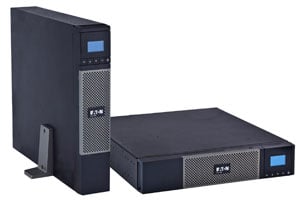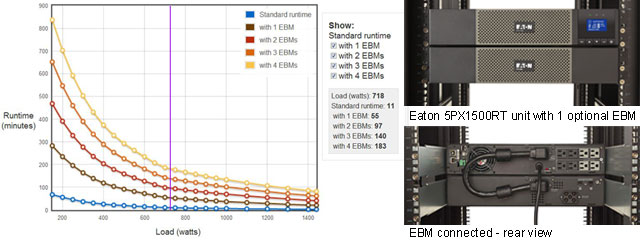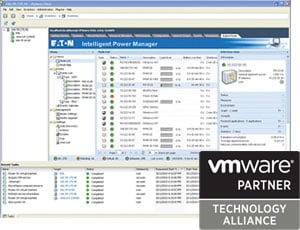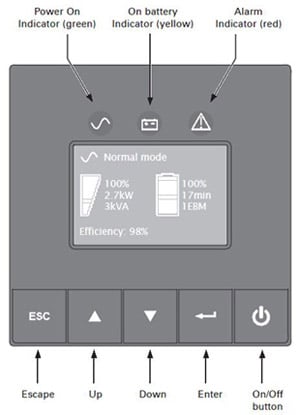Power, it’s a dirty word. Power corrupts, and I don’t just mean people and politicians. Power problems, impurities and inconsistencies are a huge contributor to problems with sensitive computer equipment. Power problems can damage hardware as well as your files and data. The losses and downtime that result from power problems cost the economy billions. Utility companies are not required by law to provide perfectly “clean” power. The “dirty” power that we get from the outlet comes with a number of impurities including blackouts, power sags, power surges, undervoltage (brownouts) and line noise. As promised , we reviewed the new Eaton 5PX1500RT, a 1500VA-class Line Interactive Uninterruptable Power Supply (UPS). Eaton is celebrating their 100th anniversary this year by introducing this new line of UPS products that feature energy consumption monitoring down to the outlet group. The 5PX line includes several models ranging from 1000VA up to 3000VA, all of which are highly manageable and can be rack-mounted and upgraded. These units are ideal for commercial or office applications like a server room or small data center.
Features & Specifications
Model: 5PX1500RT
Type: Line-Interactive High Frequency (Pure Sine wave, Buck + Boost)
Rating (VA/Watts): 1440/1440
Efficiency: up to 98%
Dimensions (H x W x D, inches): 3.4 x 17.4 x 20.6
Dimensions (H x W x D, mm): 86 x 441 x 522
Weight: 65 lbs. (29 kg.)
What’s in a name?
Eaton aims to provide some level of information within their part numbers so the “5PX1500RT” is not just a random deal. Let’s decode it, shall we? The first digit, “5” follows Eaton’s traditional 3, 5 and 9 series naming convention. Where the number (3, 5, or 9) depicts the number of common power conditions that the series addresses. The next character, the “P” is just the model type (perhaps P=Power). Next is the “X” that signifies that the 5PX has extended battery range capability with the addition of optional extended battery modules to increase runtime. So that’s the line, now moving on to the specific unit, the “1500” defines the VA level of the product and the “RT” defines that the product can be oriented in both a Rack or Tower configuration.
First Impressions
The 5PX1500RT looks like a serious data center building block. It is heavy and sturdy. Our unit arrived with a four-post rail kit for 2U rack mounting, two pedestals feet for tower orientation, quick start guide, RS-232 serial cable, USB cable, user manual CD, software CD and a Phillips head screw driver. The LCD screen looks great and on first use seems intuitive and easy to navigate. The amount of information and control you can get from this LCD control panel is immense. When powering up the unit the first thing you notice is the noise. Like an angry choir, the fans roar at high RPMs then revs down a bit while the UPS performs a full system self-test.
Front Panel The front panel features an informational LCD screen that puts a ton of information and settings at your fingertips. Above the LCD there are three LED icons, a green sine wave indicating normal operation, a yellow battery icon indicating that the UPS is running on battery and a red triangle indicating an active fault. Below the LCD you will find the power button and menu navigation buttons (up, down, enter, escape). Once the start-up and self-test process the home screen shows the current load information, battery charge percentage and run time and efficiency %.
Drilling into the menus reveals a plethora of measurements, controls, settings and information. You can literally use this little interface to load, input/output, battery, efficiency and power usage measurements; control power to outlet segments, run battery tests and restarts; set output voltages, input thresholds, utility power sensitivities, alarms and shutdown/restart sequences, network IP settings and of course set your language. Just about the only thing you can’t do here is update your Facebook status. Side note, I totally see servers, routers and network equipment getting their own Facebook profile, friending each other and updating their wall status when they need maintenance and attention. What a better way to reach out to the IT team than interrupt their Farmville session to let them know the RAID array has failed.
Naturally, the LCD panel can be rotated to match the orientation of the UPS (rack or pedestal).
Rear Panel
Around back there are more than just power outlets. Connectivity and expansion is what this box was designed for. Starting on the right you find eight 5-15R power receptacles. The four black outlets are standard, battery protected 12 Amp outlets. The four grey outlets are the magical ones, divided into two groups; each pair of outlets gets special attention, allowing you to measure power consumption of that group. The programmable groups can also be set to shed loads by cutting power, allowing more critical equipment to run on battery power longer.
To the left of the AC input plug and site wiring fault light. Above those is the Extended Battery Module (EBM) connector. Via the EBM connector the 5PX UPS allows for up to 4 external battery packs (modules) to be connected in order to increase battery run-time significantly.
Moving further left, next to an airflow output fan, you will find an RS-232 communication port, USB port, RPO/ROO connector and RJ-11 EBM connector. The RS-232 and USB ports connect the UPS to a computer, enabling the Intelligent Power Software to command your UPS and connected nodes. The RPO/ROO connector allows you to connect a “Remote Power Off” (RPO) cutoff switch that can instantly disconnect all connected equipment from power and “Remote On/Off” (ROO) button that effectively extends the physical power button to a remote location. The RJ-11 EBM connector allows the UPS to recognize Extended Battery Modules and increase runtimes automatically.
The mini-slot to the far left houses the optional ConnectUPS-MS card that extends monitoring and management to the web browser.
Batteries & Runtimes The 5PX1500RT comes with a sealed lead acid, maintenance free battery pack that consists of four 12 volt, 7.2 Ah batteries. The standard battery pack is easy to replace and can be “hot swapped” using an optional Maintenance Bypass unit to avoid downtime. To further increase battery runtime you can connect up to four, rack-mountable EBMs to your 5PX unit. An EBM is an Extended Battery Module with a self explanatory name. For an idea of battery run times see the chart below. In this case we are illustrating a 5PX1500RT under a 718 watts load (approximately 50%). The standard run-time is estimated to be 11 minutes. By adding one EBM, battery run-time goes up to 55 minutes. With two EBMs we’re at 97 minutes. Add a third EBM for over 2 hours and scaling all the way to 3 hours is possible with 4 connected EBMs. Mission critical equipment can now run safely through a power outage that would take most utility companies a couple of hours to fix.Software & Management
Eaton’s Intelligent Power Software Suite includes the two key tools you need to monitor and manage the power devices (such as UPS or PDU) on your network [including non-Eaton devices]. This free software suite is made up of the following.Intelligent Power Manager (IPM) is the “supervisory software” that facilitates management of power and environmental devices through a Web-based interface that can be accessed from any PC, anywhere on your network. Eaton’s IPM is compatible with network-enabled power devices such as UPSs, PDUs and environmental sensors. It even supports some non-Eaton UPS units. Through IPM you can monitor battery conditions, load levels and runtime. You can also perform mass firmware upgrades, customize views, centralize alarms and track equipment. So, what about virtualized environments? Intelligent Power Manager easily integrates with VMware’s vCenter, bringing power management right to your vCenter dashboard [in its own tab]. It even allows for remote shutdown of servers in clusters. What’s more, it integrates with vCenter’s vMotion and SCVMM’s Live Migration applications so you can transparently move virtual machines from a power affected server to a non-affected server on the network.
Intelligent Power Protector (IPP) is the “protection software” that monitors and protects connected devices during power events. It can be configured to automatically save any work or open files and conduct a graceful shutdown of computers and network devices. It communicates with the UPS via serial port, USB or via network (with optional Web/SNMP card) and acquires information that can be monitored, configured and updated via a web browser or through IPM.
The web-based interface for both IPM and IPP is simple, clean and easy to navigate. Pages load quickly and settings are intuitive. Newly connected network devices get automatically detected and included in the interface. Eaton’s software management tools are a definite win.
Our Experience
To test the veracity of the estimated runtime we loaded the 1500VA UPS with a mid-range server and a 15” LCD display. The server is a custom job, containing five hard drives, a single quad-core Intel Xeon processor, powered by a 750 Watt power supply. The monitor is a 15” LCD, off-brand, about 3 years old, pulls about 17 Watts. With that load the estimated battery runtime is 10 minutes. For the purpose of this test we did not connect the server to the UPS’s communication ports and we did not allow any software intervention or “graceful” shutdown. We began a 10GB file transfer to the connected server and pulled the UPS’s plug out of the wall. No change was apparent on the screen as the server was now powered by batteries. An alert sounded within a couple of seconds as we began timing the event. The batteries lasted 17 minutes before the final beep and the inevitable complete power loss.
Next we allowed the batteries to fully charge and performed the same test with IPP set to perform a graceful shutdown once the batteries are at 20%. The server ran on battery power for 8 minutes and 37 seconds before the Windows server shutdown process began. The server was off less than 1 minute later and the UPS continued to drain for a little over half an hour before it finally died.
Warranty & Support
The 5PX line of products is covered by a 3 year warranty that covers both the batteries and the UPS. It’s worth noting that only Eaton offers this kind of warranty. In comparison, both APC and Tripp-Lite offer only a 2 year warranty on their comparable products. Although we did not have any technical support issues I contacted the toll-free, 24/7 “Customer Reliability Center” and I was greeted in under a minute. I asked a question specific to this unit and I was told that since the 5PX was just released (it launched only 3 days prior to my call) he needed to have an expert call me back. I was contacted in about 30 minutes. Normally you would be transferred directly to a tech that can assist you with most questions and issues but in this case, the tech simply did not know enough about the 5PX line. Getting an expert to contact you in under an hour (in most cases under a day) is very much acceptable in my experience.
Conclusion
Eaton claims that the 5PX generously provides 28 percent more wattage than a traditional UPS. We find this to be fairly accurate given that our 5PX1500RT unit provides 1440 Watts over a comparable Tripp-Lite SMART1500 unit and APC Smart-UPS Online RT 1500VA unit that provide 1000 and 1050 Watts respectively. Priced at around $650 the Eaton is on par with the Tripp-Lite counterpart and costs less than the APC. Its flexible tower or rack orientation makes it at home in data centers and server closets alike. The communications capabilities that allow for in-depth monitoring, energy metering and remote administration at no extra cost make the 5PX line a very worthy contender for that precious rackspace. One thing to note is that at the time of our review, the outlet power metering could only be displayed on the unit’s built-in LCD. When talking to Eaton’s expert he assured me that a software update in Q3 will allow power-metering info via IPM.






